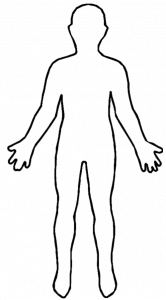A disability might increase your risk of falls at home and in the community. Falls are a serious health risk that can result in injury, hospitalization, and loss of independence. This handout lists some strategies that can help to prevent falls, and that enable you to continue confidently participating in meaningful daily activities.
Why Am I At Risk For Falls?

Neck weakness can prevent you from seeing obstacles in your path.
Ask your OT about neck braces
Shoulder weakness can cause difficulty maintaining balance or slowing a fall.
Ask your OT about home safety assessment and safe walking strategies
Core weakness can cause significant fatigue and shortness of breath when standing or walking.
Ask your OT about energy conservation, home safety equipment, and mobility aids
Hand weakness can make it difficult to use supports like railings or grab bars.
Ask your OT about safe walking strategies and home safety equipment
Hip weakness can cause difficulty standing up after sitting, or stranding/walking for long periods of time.
Ask your OT about home safety equipment and mobility aids
Ankle weakness can cause tripping/stumbling, trouble climbing stairs, and balance changes.
Ask your OT about ankle brances, mobility aids, and a home safety asessment
Fall Prevention Strategies
- Go slow and take your time – especially after sitting or lying down for a long time
- Do not multitask while walking – focus on making each step deliberate
- Use caution when reaching up or down, when turning, and when carrying items
- Use armrests or another stable surface for support when standing up or sitting down
- Regularly use any mobility aids that have been recommended for you
- Carry a cell phone, call bell, or fall alert sensor with you at all times
- Use caution on uneven ground such as grass, sidewalks, sand, snow, and ice
- Monitor your energy levels, and take breaks when needed
What Should I Do if I Fall?
- If you are injured, have hit your head, or cannot get up safely, call 911 for assistance. If possible, cover yourself with a blanket to stay warm while waiting.
- If you feel well enough to return to standing, call out and ask someone else for
assistance. Please see the link below for step-by-step instructions
https://myhealth.alberta.ca/Alberta/Pages/help-someone-get-up-fall-prevention.aspx - If no one else is around to assist you, and you feel well enough to attempt standing on your own, you may choose to follow the step-by-step instructions below https://myhealth.alberta.ca/Alberta/Pages/get-up-by-yourself-fall-prevention.aspx
If you experience a fall, advise your occupational therapist or physiotherapist so they can strategize with you about ways from experiencing anything similar in the future.
How Do I Prevent Falls at Home?
Your best option for preventing falls at home is to request a visit from a homecare occupational therapist or physiotherapist. The OT or PT will do a home visit and make recommendations specific to your home. In general:
- Remove area rugs and clutter from the floor
- Install grab bars in your shower
- Keep your home well-lit and use nightlights between the bedroom and bathroom
- If you have a mobility aid such as a cane or walker, keep it within reach at all times
- Wear supportive shoes or slippers (not flip flops or socks) when walking
How Do I Prevent Falls on the Stairs?
Stairs are one of the most dangerous walking environments we use on a daily basis. These strategies will help to decrease your risk at home or in the community:
- Always hold on to the railing, and consider adding a second railing if required.
- Go up or down stairs one step at a time. Lead with your stronger side on the way up, and
the weaker side on the way down. - Limit carrying items on the stairs as much as possible
- Take breaks if required, and try to limit stair climbing throughout the day
- If stairs become very fatiguing or cause you anxiety, talk to your OT to see if a stair glide
or other assistive device may be beneficial for you

